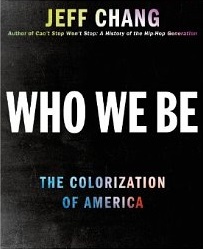 Race. Multiculturalism. Diversity. Culture. Big words that it sometimes seems we talk around and around. Jeff Chang’s new book Who We Be: The Colorization of America–released today–takes a big step in helping to provide a vocabulary and a history to America’s long relationship with this complex topic through images and ideas.
Race. Multiculturalism. Diversity. Culture. Big words that it sometimes seems we talk around and around. Jeff Chang’s new book Who We Be: The Colorization of America–released today–takes a big step in helping to provide a vocabulary and a history to America’s long relationship with this complex topic through images and ideas.
By teasing out the development and evolution of conversations on race from the 1960s through to today’s “post-racial” moments, Chang guides us through the back story of the different ways that the United States has talked about race, color, whiteness, and other topics. Though the book is a bit lengthy and looks like a lot to take on, Chang uses art and culture as his (ready and accesible) entry points to think about visuals as both overt and subtle influencers — about artists and culture makers who have provoked conversations and confrontations behind bigger iconic moments in American history, and about people of color asking for visibility and acceptance however they defined it.
In the introduction of Who We Be, Chang lays it out:
We can all agree that race is not a question of biology. Instead it is a question of culture and it begins as a visual problem, one of vision and visuality. Race happens in the gap between appearance and the perception of difference. It is about what we see and what we think we see and what we think about when we see. In that sense, it’s bigger than personal affinities, preferences, tastes, and bonds.
Through liberal and conservative moments, progress and setbacks, Chang unfolds his narrative over a wide range of subjects, from art, advertisement, and history, to the definitions of words, crises of whiteness, crises of color, and questions of representation and presence. He builds on the project begun in Can’t Stop, Won’t Stop which looks at the history of hip-hop, its creators and influencers. So what makes this book, among all the books being released today, worth reading?
Among the most wonderful things in this book (aside from the overwhelming deposit of knowledge Chang has compiled) is the continued insertion of Morrie Turner’s insightful and witty comics, Wee Pals, which saw its national debut in 1965 (Turner also drew an equally witty single-panel cartoon Humor in Hue). I had never heard of them before, but Turner’s strips, beautifully turn stereotypes and fears on their heads, with his cast of young and diverse characters joking over miscommunications and mistranslations.
Admittedly Chang’s book is a bit of an undertaking and almost intimidatingly large. For that reason, the narrative occasionally stalls, but overall Chang writes in an accessible fashion that smoothly transitions between micro and macro stories, and excels in using individuals and artists to delve into the long struggle to control and shape the future of America. Even if read in one short chapter at a time, it is elucidating. He connects the dots across multiple decades continuing to today, a period of time that often gets the short end of the stick analytically and historically. And perhaps brings us one step closer to having a national language, vocabulary, and wherewithal to discuss and delve into these topics.
And aside from the fact that Chang’s book forces us consider big questions, it also reminds us of how previous generations have dealt with these same topics. While times have changed, the discussions on color that emerge in politics and are reflected in our arts and culture evolve, circle back, and bring in new voices. Obama’s statement from his infamous race speech (prior to his election and before we were “postracial”), already several years old, still rings true: “The complexities of race in this country that we’ve never really worked through [remain] a part of our union that we have yet to perfect.”
It often feels like I am part of a generation that both embraces diversity, and at the same time does not always know how to talk about race and class, cannot see down the history of earlier protests, moments, ideas. That sometimes, we struggle and stall in trying to reinvent a wheel that could create alliances and promote change (and I entirely inculcate myself in this mix and this flaw) — that we’re missing tools that ought to already exist. So when Chang writes, as he enters the twenty-first century, “But yet another American generation could not begin to discuss how to live together. Just as their elders once had difficulty imagining a post-segregated nation, they could not imagine a future after the culture wars,” it resonates. What do we imagine our future to be? Connecting past and present, this book is one answer, and even more questions in response, on how to imagine the nation. A chance to be inspired and re-invigorated, to take a new look at who we be.





